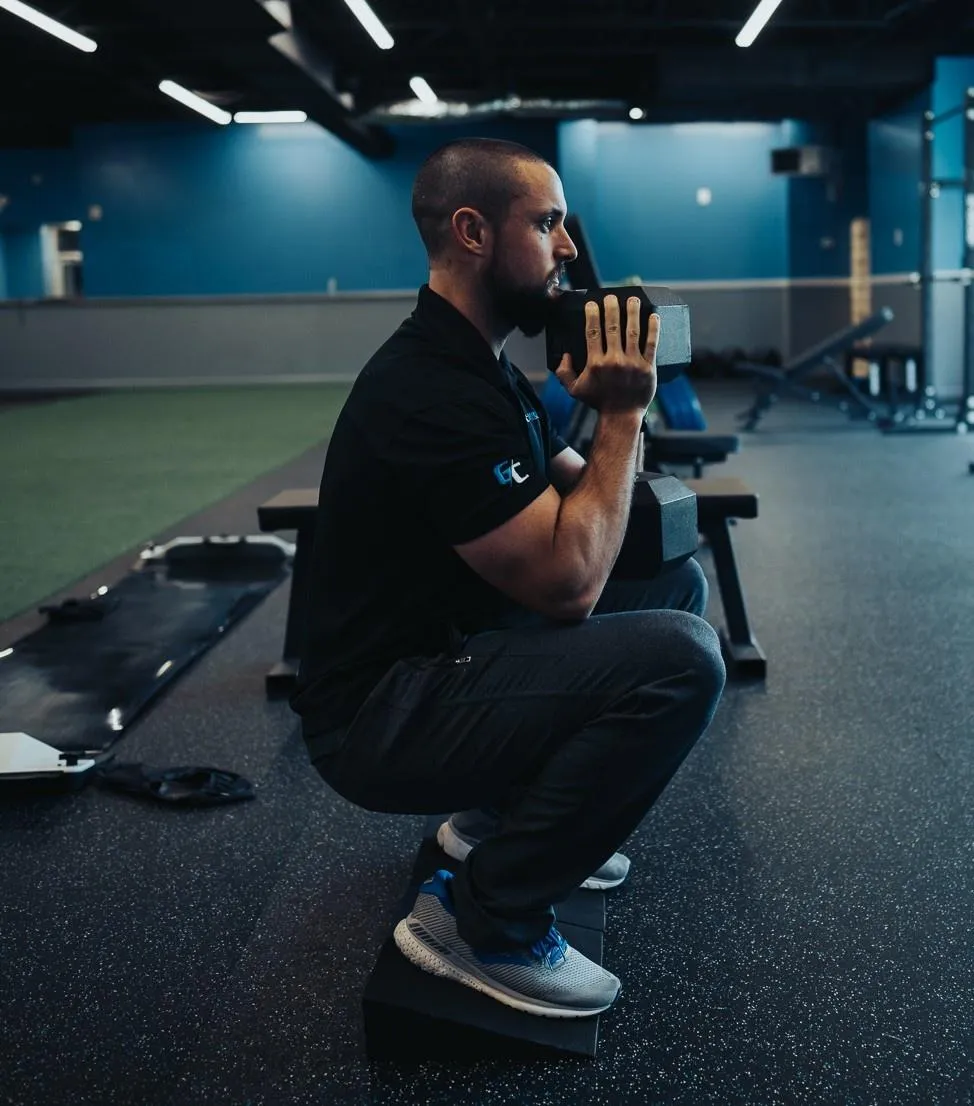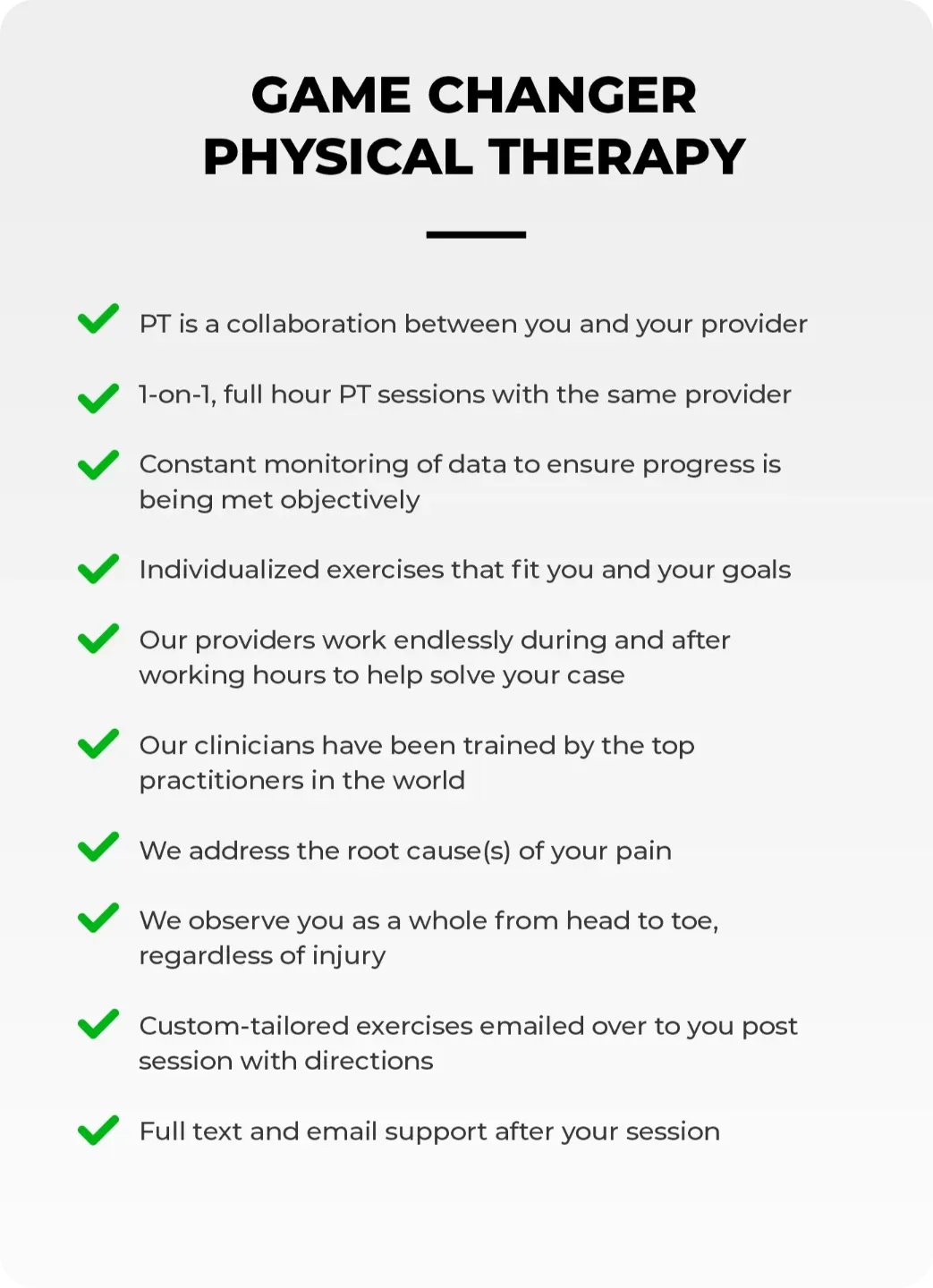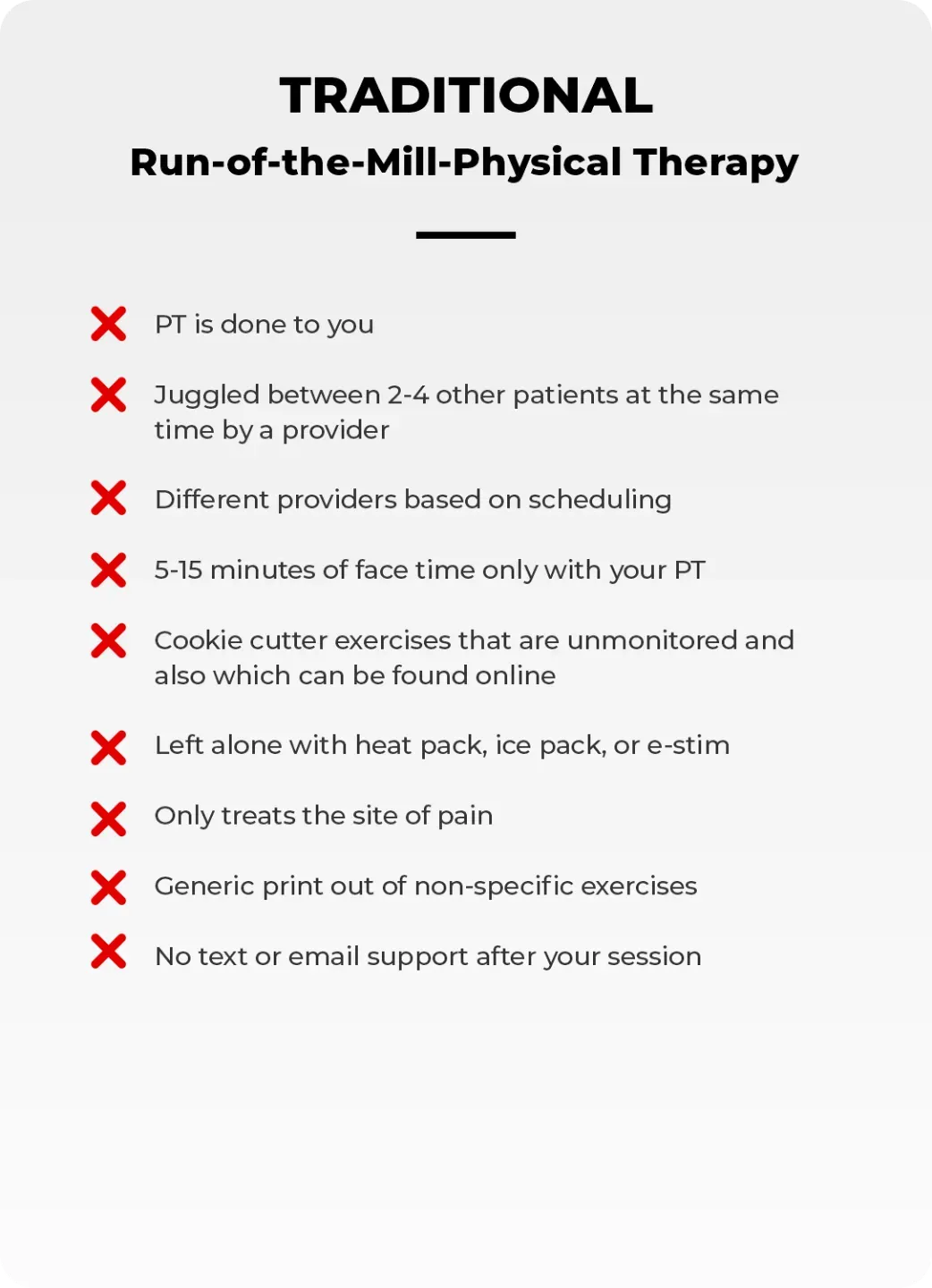Tried PT, Chiro, and Still Not Moving Like You Know You Should? It’s Time to Stop Guessing and Start Solving.
We help active adults who’ve “done the rounds” finally understand why they’re still in pain — and unlock performance-driven solutions that actually stick. No surgery. No fluff. Just results backed by science and movement that makes sense.

Most people don’t think about their health—until it hurts.
Life gets busy, pain shows up, and only then do we start looking for help.
If you’re lucky, you land in the right hands early and get the clarity and care you need. But for most, the story’s different.
You get bounced around a confusing medical system.
You try PT. You try chiro. Maybe even injections or imaging.
But the pain sticks around—and so does the frustration, the doubt, and the exhaustion.
Eventually, you're told it’s just your age... your genetics... or something you’ll just have to “live with.”
Some accept that answer. But other people like you don’t.
You dig. You research. You chase solutions.
You spend time, energy, and money trying to figure out what everyone else missed.
If that’s where you are, you’ve come to the right place.
And if you’re just starting your journey and somehow found us early? Even better.
Here’s the Game Changer difference:
We don’t chase symptoms.
We don’t guess.
We get to the root.
We listen. We explain. We build real plans that work for your body and your goals.


Your Journey

*If we feel like we cannot truly help you, we will let you know.
Honesty and transparency are key for a therapeutic relationship.
Success Stories

Michael J
★ ★ ★ ★ ★
Jeremy is a fantastic PT! He is extremely knowledgeable and shows genuine compassion towards his patients and his enthusiastic about the physical therapy profession. He takes the time and effort to make individualized treatment plans for each one of his patients, and does check-ups before and after each session to ensure his chosen interventions are actually making a difference and helping the patient reach their goals. I’d recommend any family member to go to Jeremy for treatment.

Ashleigh A
★ ★ ★ ★ ★
I am a collegiate athlete who came to Jeremy with years of undiagnosed, seemingly unfixable shoulder pain. He approached the situation with an open mind and took many varying factors into consideration, which is not something that I had been lucky enough to experience prior to working with him. After years of being told that my shoulder was "untreatable" and that I would have to play my sport in constant pain, Jeremy was able to contradict those statements and resolve my issue in minimal sessions. I am so appreciative of what Jeremy has done for me, and I would recommend anyone, athlete or not, go to Game Changer Physical Therapy.

Bobby A
★ ★ ★ ★ ★
I've been to plenty of PT's throughout the years and Jeremy at Gamechanger is the Best Physical Therapist in New Jersey. He spends the time on fixing the cause of the injury so you don't end up back there again for the same thing. Highly recommend.

Priya K
★ ★ ★ ★ ★
Dr. Dave is the BEST physical therapist I’ve been to! He is extremely knowledgeable, thorough, has excellent bed side manner and listens to his patients concerns intently! He is extremely dedicated to helping his patients (in person and virtually) and his PT techniques are easy yet effective! In just two sessions, I have felt significantly better and am back to working out and am pain free! I would definitely recommend Dr. Dave to anyone who has been struggling with chronic pain and is looking for quick/ lasting relief and maintaining a healthy active lifestyle!

Nikki G.
★ ★ ★ ★ ★
In March of 2015 I was participating in a HIIT workout. I had learned a new movement that day that was incorporated into the workout. I was not fully comfortable with the movement but against my better judgment I moved forward with participating in the workout for the day. About halfway through the workout I felt a warm rush of heat down my right leg. I dropped the barbell and immediately knew that something was wrong. What I did not know was how much that one decision would affect my functions in daily life moving forward.
I ended up herniating two discs in my lower back. I started off with receiving physical therapy by itself at first. While it helped me I would have frequent spasms that would last a few days and then I would be ok for a few months. The spasms became more and more frequent over time. I went to the physiatrist and began injections along with continuing physical therapy. In a year and a half time span I received two facet joint injections and six epidurals. While they helped I still was limited in my day to day routines. I still could not workout consistently and had to miss work periodically because I was not able to stand up at times. In May of 2018 things got so bad I ended up in a hospital for 5 days, and lost feeling in the area of my pelvis and right lower abdominals for about two weeks. I was released from the hospital having to use a walker and given a bunch of muscle relaxers. Doctors were making me feel like I was crazy because I would be told that my case was mild yet none of these reactions were mild. I mean, I was in my late 30's and had to use a walker! This was not normal or mild! By this point I was at my wit's end. I went to a rheumatologist, another orthopedic, and a neurologist determined to figure out how to get this under control and take my life back. I was desperate. The neurologist I found was quite helpful. She took me off of the muscle relaxers and put me on a low dose of daily nerve medication. Then she sent me back to physical therapy.
It was some time later that I found Dr. Dave Kim. He took the time to actually listen to me, made me feel validated in what I was thinking and feeling. He did a really thorough evaluation of me, the most thorough I had ever had. Dr. David Kim gave me his full attention during my sessions with him and has literally been a miracle worker. It was refreshing to have someone actually hear you and show that they care. He followed up with me every step of the way even in the little spare time that he had. Couple of sessions with him and my spasms have stopped and I’m feeling the best I have felt in a long, long time. Dr. Dave is aces and I cannot say enough about him. If you are experiencing chronic pain, fed up with the healthcare system and feel like you are being ignored and cast to the side, look no further. He is the real deal.
Are you tired and frustrated of remaining in pain no matter what you try? Are you ready to take back control of your life and work with trusted providers who have your best interest in mind?
FREQUENTLY ASKED QUESTIONS
What is the difference between Game Changer Physical Therapy and other companies?
We don’t gamble with your health by providing cookie cutter exercises for the site of pain. We utilize a holistic approach that looks at your entire body to uncover the root cause(s) of your pain. Our assessment and reassessment process is extremely thorough to ensure progress is made every session. You will leave day one with a clear understanding of your pain and how we plan to address it.
How long are your sessions?
Our sessions are 1-on-1 for the full hour with the same physical therapist to maximize your outcomes.
How many sessions will I need?
After your initial evaluation, your physical therapist will be able to determine a recommendation based on the findings and your needs. Nearly all clients feel noticeable changes and degrees of relief even after the first session!
What is your cancellation/rescheduling policy?
All appointments will require a minimum 24 hours notice to avoid being charged for the session. This is to ensure fairness for all other patients who need to see us. We understand medical and life emergencies happen so those cancellations will be reviewed on a case by case basis.
Do you guys take insurance?
We are an out-of-network provider. Our team will take down your insurance information and verify your benefits. We are not directly in contract with insurances so depending on your coverage, we can discuss and provide the most cost-effective options for you.
Do you accept HSA/FSA?
We do accept HSA/FSA.
Do you offer virtual sessions?
We offer virtual sessions on a case by case basis. We have found tremendous success for those who have been treated virtually, but we do not feel it is appropriate for ALL people. After the consultation, we will have a better idea to gauge whether it would be appropriate for you.
How can I trust that you can help me?
We often work with patients that have been burned by the healthcare system before, so skepticism is natural. We don't expect new patients to just trust us without experiencing what makes us different. That is why we offer a free consultation to all new patients. This allows you to come in-person, familiarize yourself with the clinic, meet your physical therapist and determine if we are a good fit for you.
Will I have access to my Physical Therapist outside of my appointment?
Absolutely. We believe that Physical therapy isn’t something that’s done unto you, but rather, it is a collaborative relationship that requires full effort from both parties. As such, we offer full text and email support even after your session to ensure there is no confusion and progress is being made.
I’ve seen other Physical Therapy clinics offering “Full Body Treatments.” How is yours different?
We believe that the interpretation and use of words are left to the beholder based on their background. When most clinics refer to a full body approach, they usually treat above and below the site of pain and incorporate core strengthening. In our lens, we don’t believe the different segments of the body work in isolation; rather, the whole body is intimately connected. As such, we need to perform a thorough assessment of each individual from head to toe and formulate tailored exercises that appreciates what each part of the body is doing at all times. The true root cause of your pain may be coming from areas away from your site of pain. Getting tunnel vision with treatment is the number one reason we find people having poor success with previous physical therapy efforts.

400 Madison Ave Manalapan, NJ 07726
phone: (732) 740-5384
fax: (732)-481-0120
Hours: Mon, Wed, Thurs: 12pm-8pm
Tues: 9am-5pm Fri: 9am-4pm